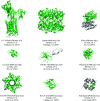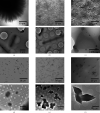Macromolecular crystallography using microcrystal electron diffraction
- PMID: 33645535
- PMCID: PMC7919406
- DOI: 10.1107/S2059798320016368
Macromolecular crystallography using microcrystal electron diffraction
Abstract
Microcrystal electron diffraction (MicroED) has recently emerged as a promising method for macromolecular structure determination in structural biology. Since the first protein structure was determined in 2013, the method has been evolving rapidly. Several protein structures have been determined and various studies indicate that MicroED is capable of (i) revealing atomic structures with charges, (ii) solving new protein structures by molecular replacement, (iii) visualizing ligand-binding interactions and (iv) determining membrane-protein structures from microcrystals embedded in lipidic mesophases. However, further development and optimization is required to make MicroED experiments more accurate and more accessible to the structural biology community. Here, we provide an overview of the current status of the field, and highlight the ongoing development, to provide an indication of where the field may be going in the coming years. We anticipate that MicroED will become a robust method for macromolecular structure determination, complementing existing methods in structural biology.
Keywords: 3D electron diffraction; electron crystallography; macromolecular crystallography; methods development; microcrystal electron diffraction.
open access.
Figures




Similar articles
-
Advances and applications of microcrystal electron diffraction (MicroED).Curr Opin Struct Biol. 2024 Feb;84:102741. doi: 10.1016/j.sbi.2023.102741. Epub 2023 Dec 11. Curr Opin Struct Biol. 2024. PMID: 38086321 Free PMC article. Review.
-
Microcrystal electron diffraction in macromolecular and pharmaceutical structure determination.Drug Discov Today Technol. 2020 Dec;37:93-105. doi: 10.1016/j.ddtec.2020.12.002. Epub 2020 Dec 31. Drug Discov Today Technol. 2020. PMID: 34895659 Review.
-
Comparing serial X-ray crystallography and microcrystal electron diffraction (MicroED) as methods for routine structure determination from small macromolecular crystals.IUCrJ. 2020 Feb 26;7(Pt 2):306-323. doi: 10.1107/S205225252000072X. eCollection 2020 Mar 1. IUCrJ. 2020. PMID: 32148858 Free PMC article.
-
Visualizing drug binding interactions using microcrystal electron diffraction.Commun Biol. 2020 Jul 31;3(1):417. doi: 10.1038/s42003-020-01155-1. Commun Biol. 2020. PMID: 32737395 Free PMC article.
-
An Overview of Microcrystal Electron Diffraction (MicroED).Annu Rev Biochem. 2021 Jun 20;90:431-450. doi: 10.1146/annurev-biochem-081720-020121. Annu Rev Biochem. 2021. PMID: 34153215 Free PMC article. Review.
Cited by
-
Small but mighty: the power of microcrystals in structural biology.IUCrJ. 2025 May 1;12(Pt 3):262-279. doi: 10.1107/S2052252525001484. IUCrJ. 2025. PMID: 40080159 Free PMC article. Review.
-
Protein Lipidation Types: Current Strategies for Enrichment and Characterization.Int J Mol Sci. 2022 Feb 21;23(4):2365. doi: 10.3390/ijms23042365. Int J Mol Sci. 2022. PMID: 35216483 Free PMC article. Review.
-
Microcrystal electron diffraction structure of Toll-like receptor 2 TIR-domain-nucleated MyD88 TIR-domain higher-order assembly.Acta Crystallogr D Struct Biol. 2024 Sep 1;80(Pt 9):699-712. doi: 10.1107/S2059798324008210. Epub 2024 Sep 4. Acta Crystallogr D Struct Biol. 2024. PMID: 39268708 Free PMC article.
-
DIALS as a toolkit.Protein Sci. 2022 Jan;31(1):232-250. doi: 10.1002/pro.4224. Epub 2021 Nov 24. Protein Sci. 2022. PMID: 34747533 Free PMC article.
-
Comprehensive microcrystal electron diffraction sample preparation for cryo-EM.Nat Protoc. 2025 May;20(5):1275-1309. doi: 10.1038/s41596-024-01088-7. Epub 2024 Dec 20. Nat Protoc. 2025. PMID: 39706914 Review.
References
-
- Arndt, U. W. & Wonacott, A. J. (1977). The Rotation Method in Crystallography. Amsterdam: North Holland.
-
- Barends, T. R. M., Foucar, L., Botha, S., Doak, R. B., Shoeman, R. L., Nass, K., Koglin, J. E., Williams, G. J., Boutet, S., Messerschmidt, M. & Schlichting, I. (2014). Nature, 505, 244–247. - PubMed
Publication types
MeSH terms
Substances
Grants and funding
LinkOut - more resources
Full Text Sources
Other Literature Sources

